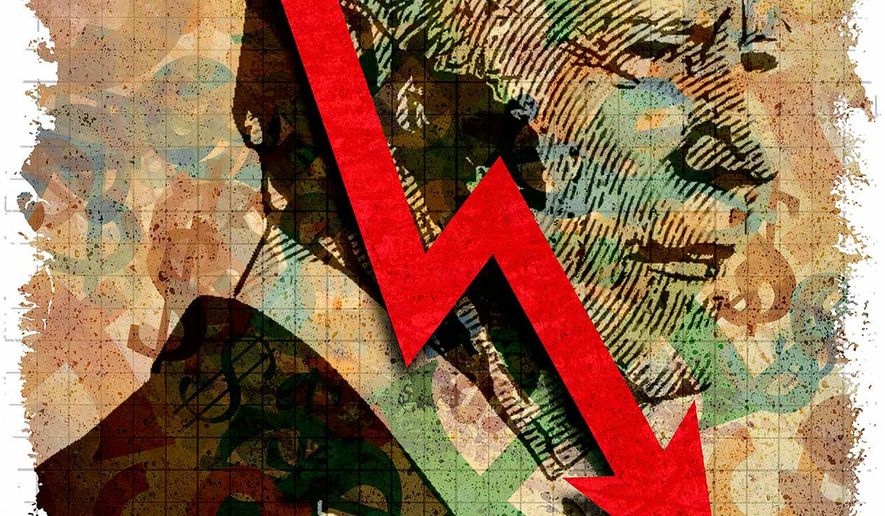OPINION:
The economy is improving, but President Biden doesn’t get much credit. Now it appears that could be enough to cost him his job.
In contrast to last summer, most economists put the likelihood of a recession at less than half.
Although the National Bureau of Economic Research considers several variables, including retail and wholesale sales, nonfarm employment and industrial production to date business cycles, two quarters of negative growth in gross domestic product are usually associated with a recession.
After impressive gains this past summer, surveys of economic forecasters indicate GDP growth will slip to less than 1% in the fourth quarter of this year and first half of 2024, but it shouldn’t go negative.
Inflation has slowed but continues well above the Federal Reserve’s 2% target. And since Mr. Biden took office, consumer prices are up 17%, but wages have increased only 13%.
Americans don’t just want the rate of inflation to go down; they would like the price increases of the last two years rolled back. After all, pandemic-era bottlenecks have resolved, and we read about robots and artificial intelligence making us more productive, so why aren’t we living better?
Prices for items such as gasoline and produce respond to the ups and downs of supply and demand, and some have fallen back. Once most prices rise, they may stay flat for long periods, but they don’t roll back.
When was the last time your favorite sit-down restaurant printed new menus with lower prices, or the cost of a haircut go down — even when business is poor?
In the middle aisles of supermarkets — where household items like paper towels and canned goods are featured — manufacturers may distribute more coupons, but the discounts are generally from a higher base than the last time they had too much inventory.
Presidents Trump and Biden both signed off on big pandemic relief payments to businesses, households and the unemployed in 2020 and 2021, respectively.
Real household income took big temporary jumps. A good deal of that money was saved, not spent, because lockdowns kept consumers at home.
Consequently, big federal deficits that paid for the largesse did not immediately translate into too much demand that would eventually push up inflation. The pandemic, even in the face of towering unemployment, made Americans feel richer than they were.
When the economy reopened, Americans started spending that money. And along with the big sums marshaled by Mr. Biden for infrastructure, industrial policies and assistance to Ukraine, inflation rocketed, and the pandemic gains to household incomes became losses.
Mr. Biden’s spending has not translated, for example, into shorter travel time on Amtrak or stronger manufacturing — which he says is key to revitalizing prosperity.
The share of voters who approve of Mr. Biden’s handling of the economy lags those that disapprove by more than 20 points. He gets similarly low marks for his handling of inflation, immigration, crime and foreign policy.
The measure that is most alarming and likely indicate voter distemper with the president’s overall progressive agenda is that only about one-quarter of voters think the country is on the right track, while two-thirds say it is on the wrong track.
If we step back to look, so many things have not improved — or gotten worse.
College continues to become less affordable.
Mr. Biden has relieved the pain of student loans for some, but for most heavily indebted young people, the payments are back — often smothering dreams of buying a home, having more children, and sometimes having children at all.
The cost of a typical home is $412,000. Along with the high interest rates caused by Mr. Biden’s big federal deficits and the Federal Reserve’s efforts to curb inflation, it takes a yearly household income of $115,000 to comfortably meet the payments. The median annual household income is only $75,000.
Homelessness is increasing among older Americans because many can no longer pay rent.
In September, when this column addressed former President Donald Trump’s prospects for reclaiming the Oval Office, polls indicated the former president enjoyed a slight advantage in the popular vote. But his gains among voters from 2020 were heavily concentrated in states he’d win or lose regardless of the shifts.
The Electoral College tally likely favored Mr. Biden, because the president was ahead in swing states that Mr. Trump had flipped to win the 2016 election: Pennsylvania, Michigan and Wisconsin.
Now the polling data indicate those swing states and others are moving in Mr. Trump’s direction.
State data for real household income is available only on an annual basis. The tally for 2022 indicates income losses are concentrated across the Northeast and industrial Midwest — including swing states like Ohio and the three mentioned above.
As Americans read their pay stubs and stroll down supermarket aisles, “Bidenomics” is a bust, and even Democrats don’t want him to run again.
• Peter Morici is an economist and emeritus business professor at the University of Maryland, and a national columnist.




Please read our comment policy before commenting.